gearbox Citroen DS5 2014 1.G Owner's Manual
[x] Cancel search | Manufacturer: CITROEN, Model Year: 2014, Model line: DS5, Model: Citroen DS5 2014 1.GPages: 372, PDF Size: 32.58 MB
Page 5 of 372
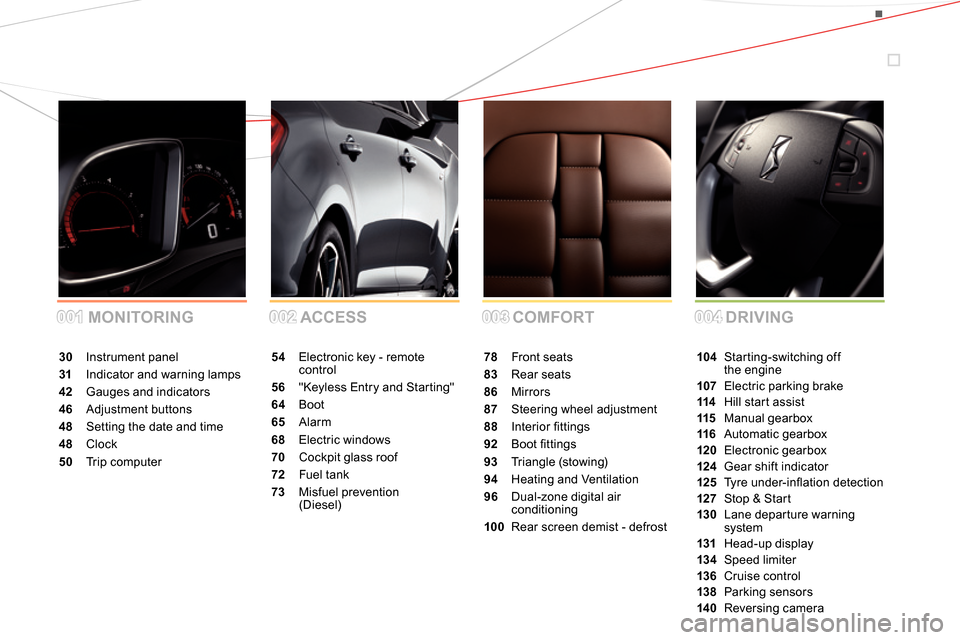
001001002002003003004004 COMFORT ACCESS MONITORINGDRIVING
30 Instrument panel
31 Indicator and warning lamps
42 Gauges and indicators
46 Adjustment buttons
48 Setting the date and time
48 Clock
50 Tr i p c o m p u t e r54 Electronic key - remote
control
56 "Keyless Entry and Starting"
64 Boot
65 Alarm
68 Electric windows
70 Cockpit glass roof
72 Fuel tank
73 Misfuel prevention
(Diesel)78 Front seats
83 Rear seats
86 Mirrors
87 Steering wheel adjustment
88 Interior fi ttings
92 Boot fi ttings
93 Triangle (stowing)
94 Heating and Ventilation
96 Dual-zone digital air
conditioning
100 Rear screen demist - defrost104 Starting-switching off
the engine
107 Electric parking brake
114 Hill start assist
115 Manual gearbox
116 Automatic gearbox
120 Electronic gearbox
124 Gear shift indicator
125 Ty r e u n d e r- i nfl ation detection
127 Stop & Start
130 Lane departure warning
system
131 Head-up display
13 4 Speed limiter
136 Cruise control
138 Parking sensors
14 0 Reversing camera
Page 23 of 372
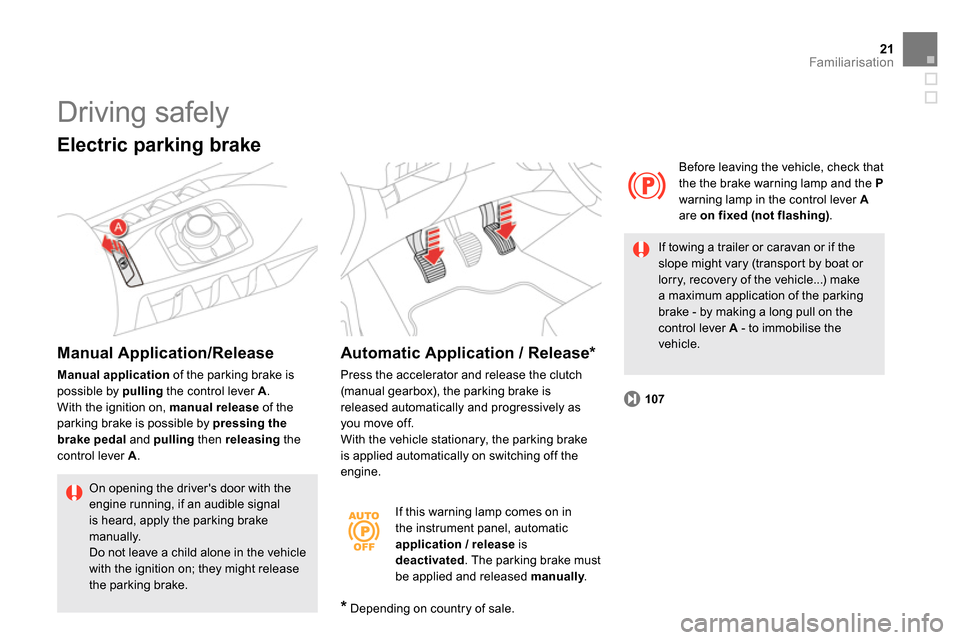
107
21Familiarisation
If this warning lamp comes on in
the instrument panel, automatic
application / release
is
deactivated
. The parking brake must
be applied and released manually
.
Before leaving the vehicle, check that
the the brake warning lamp and the P
warning lamp in the control lever A
are on fixed (not flashing)
.
If towing a trailer or caravan or if the
slope might vary (transport by boat or
lorry, recovery of the vehicle...) make
a maximum application of the parking
brake - by making a long pull on the
control lever A
- to immobilise the
vehicle.
*
Depending on country of sale.
Automatic Application / Release *
Press the accelerator and release the clutch
(manual gearbox), the parking brake is
released automatically and progressively as
you move off.
With the vehicle stationary, the parking brake
is applied automatically on switching off the
engine.
On opening the driver's door with the
engine running, if an audible signal
is heard, apply the parking brake
manually.
Do not leave a child alone in the vehicle
with the ignition on; they might release
the parking brake.
Manual Application/Release
Manual application
of the parking brake is
possible by pulling
the control lever A
.
With the ignition on, manual release
of the
parking brake is possible by pressing the
brake pedal
and pulling
then releasing
the
control lever A
.
Electric parking brake
Driving safely
Page 24 of 372

104
Starting at temperatures
above zero
- Press the brake pedal.
- Make one short press (about one second)
on the START/STOP
button.
Starting at temperatures
below zero
You must initiate preheating of the Diesel
engine:
- Without
placing your foot on the brake
pedal, make a first short press on the
START/STOP button.
- Wait until the preheater warning lamp
goes off.
- With
your foot on the brake pedal, make
a second short press on the START/
STOP button.
Driving safely
Starting - stopping the engine
Before starting
- Place the gear lever in neutral or in
position N
for an electronic or automatic
gearbox.
- Insert the electronic key in the reader or
keep the Keyless Entry and Starting key in
the vehicle.
Page 25 of 372

13 4
136124
23Familiarisation
Driving safely
Speed limiter "LIMIT"
1.
Selecting speed limiter mode.
2.
Decrease the programmed value.
3.
Increase the programmed value.
4.
Pause/resume speed limiter.
5.
Display of the memorised speeds (by the
audio system memory).
These values must be set with the engine running.
Cruise control "CRUISE"
1.
Selecting cruise control mode.
2.
Programming a speed / Decrease the
programmed value.
3.
Programming a speed / Increase the
programmed value.
4.
Pause/resume cruise control.
5.
Display of the memorised speeds (by the
audio system memory).
In order to be programmed or activated, the
vehicle speed must be higher than 25 mph
(40 km/h), with at least 4th gear engaged on a
manual gearbox (2nd gear on an electronic or
automatic gearbox).
Display in the instrument panel
The cruise control or speed limiter mode
appears in the instrument panel when it is
selected.
Gear shift indicator
The system may suggest the most suitable
gear to select.
Page 26 of 372

127
128 128
Driving safely
Stop & Start
Going into engine STOP mode
The "ECO"
warning lamp comes on
in the instrument panel and the engine
goes into standby automatically:
Going into engine START mode
Deactivation / Reactivation
The system is automatically reactivated
every time the engine is started with
the START/STOP button.
Before refuelling or doing anything
under the bonnet, you must switch
off the ignition with the START/STOP
button.
The "ECO"
warning lamp goes off
and the engine restarts automatically:
- with a manual gearbox
, when you fully
depress the clutch pedal,
- with an electronic gearbox
:
●
gear lever in position A
or M
, when you
release the brake pedal,
●
or gear lever in position N
and brake
pedal released, when you place the gear
lever in position A
or M
,
●
or when you engage reverse.
- with
an
automatic gearbox
:
●
gear lever in position D
or M
, when you
release the brake pedal,
●
or gear lever in position N
and brake
pedal released, when you place the gear
lever in position D
or M
,
●
or when you engage reverse.
You can deactivate the system at any time by
pressing the "ECO OFF"
button; the button's
warning lamp comes on.
- with a manual gearbox
, at speeds below
12 mph (20 km/h) or vehicle stationary with
the Blue HDi 120 version, when you put the
gear lever into neutral, and you release the
clutch pedal,
- with an electronic gearbox,
at speeds
below 5 mph (8 km/h), when you press
the brake pedal or place the gear lever in
position N
,
-
with an automatic gearbox
, vehicle
stationary, when you press the brake pedal
or place the gear lever in position N
.
In certain circumstances, the STOP mode
may not be available; the "ECO"
warning lamp
flashes for a few seconds, then goes off.
In certain circumstances, START mode may be
invoked automatically; the "ECO"
warning lamp
flashes for a few seconds, then goes off.
Page 27 of 372
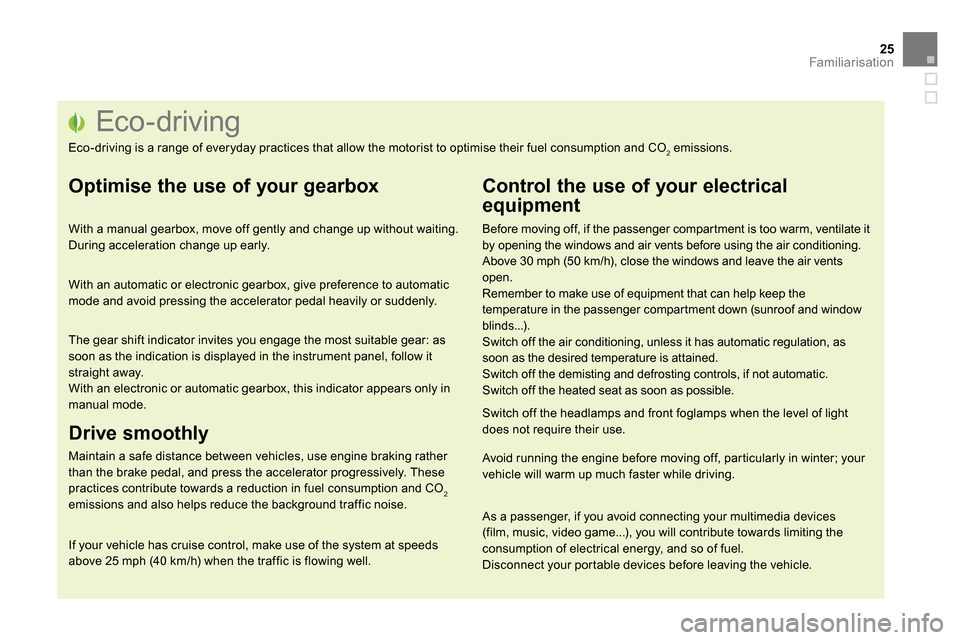
25Familiarisation
Eco-driving
Eco-driving is a range of everyday practices that allow the motorist to optimise their fuel consumption and CO2 emissions.
Optimise the use of your gearbox
With a manual gearbox, move off gently and change up without waiting.
During acceleration change up early.
With an automatic or electronic gearbox, give preference to automatic
mode and avoid pressing the accelerator pedal heavily or suddenly.
The gear shift indicator invites you engage the most suitable gear: as
soon as the indication is displayed in the instrument panel, follow it
straight away.
With an electronic or automatic gearbox, this indicator appears only in
manual mode.
Drive smoothly
Maintain a safe distance between vehicles, use engine braking rather
than the brake pedal, and press the accelerator progressively. These
practices contribute towards a reduction in fuel consumption and CO
2
emissions and also helps reduce the background traffic noise.
If your vehicle has cruise control, make use of the system at speeds
above 25 mph (40 km/h) when the traffic is flowing well.
Control the use of your electrical
equipment
Before moving off, if the passenger compartment is too warm, ventilate it
by opening the windows and air vents before using the air conditioning.
Above 30 mph (50 km/h), close the windows and leave the air vents
open.
Remember to make use of equipment that can help keep the
temperature in the passenger compartment down (sunroof and window
blinds...).
Switch off the air conditioning, unless it has automatic regulation, as
soon as the desired temperature is attained.
Switch off the demisting and defrosting controls, if not automatic.
Switch off the heated seat as soon as possible.
Switch off the headlamps and front foglamps when the level of light
does not require their use.
Avoid running the engine before moving off, particularly in winter; your
vehicle will warm up much faster while driving.
As a passenger, if you avoid connecting your multimedia devices
(film, music, video game...), you will contribute towards limiting the
consumption of electrical energy, and so of fuel.
Disconnect your portable devices before leaving the vehicle.
Page 32 of 372
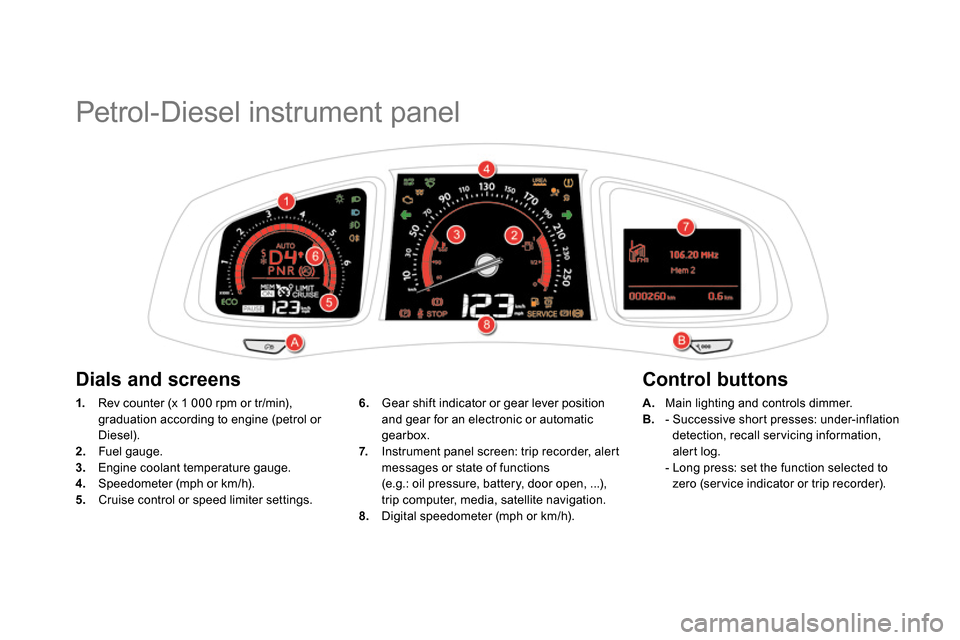
Petrol-Diesel instrument panel
1.
Rev counter (x 1 000 rpm or tr/min),
graduation according to engine (petrol or
Diesel).
2.
Fuel gauge.
3.
Engine coolant temperature gauge.
4.
Speedometer (mph or km/h).
5.
Cruise control or speed limiter settings.
A.
Main lighting and controls dimmer.
B.
- Successive short presses: under-inflation
detection, recall ser vicing information,
alert log.
- Long press: set the function selected to
zero (ser vice indicator or trip recorder).
6.
Gear shift indicator or gear lever position
and gear for an electronic or automatic
gearbox.
7.
Instrument panel screen: trip recorder, alert
messages or state of functions
(e.g.: oil pressure, battery, door open, ...),
trip computer, media, satellite navigation.
8.
Digital speedometer (mph or km/h).
Dials and screens
Control buttons
Page 35 of 372
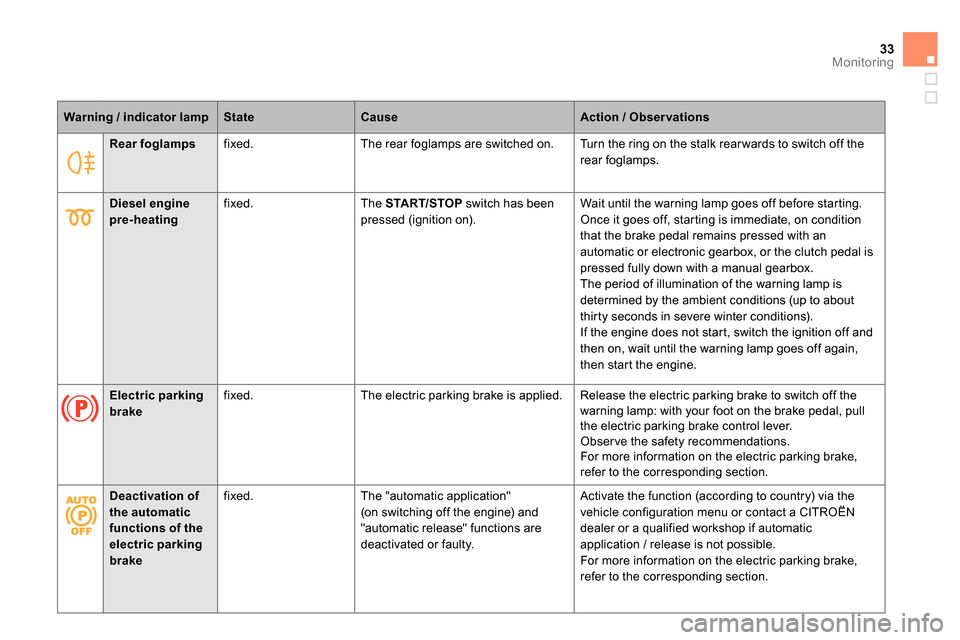
33Monitoring
Rear foglamps
fixed. The rear foglamps are switched on. Turn the ring on the stalk rear wards to switch off the
rear foglamps.
Warning / indicator lamp
State
Cause
Action / Observations
Diesel engine
pre-heating
fixed. The START/STOP
switch has been
pressed (ignition on). Wait until the warning lamp goes off before starting.
Once it goes off, starting is immediate, on condition
that the brake pedal remains pressed with an
automatic or electronic gearbox, or the clutch pedal is
pressed fully down with a manual gearbox.
The period of illumination of the warning lamp is
determined by the ambient conditions (up to about
thirty seconds in severe winter conditions).
If the engine does not start, switch the ignition off and
then on, wait until the warning lamp goes off again,
then start the engine.
Electric parking
brake
fixed. The electric parking brake is applied. Release the electric parking brake to switch off the
warning lamp: with your foot on the brake pedal, pull
the electric parking brake control lever.
Obser ve the safety recommendations.
For more information on the electric parking brake,
refer to the corresponding section.
Deactivation of
the automatic
functions of the
electric parking
brake
fixed. The "automatic application"
(on switching off the engine) and
"automatic release" functions are
deactivated or faulty. Activate the function (according to country) via the
vehicle configuration menu or contact a CITROËN
dealer or a qualified workshop if automatic
application / release is not possible.
For more information on the electric parking brake,
refer to the corresponding section.
Page 40 of 372

Warning / indicator lamp
State
Cause
Action / Observations
Electric parking
brake
flashing. The electric parking brake is not
applied automatically.
The application/release is faulty. You must stop as soon as it is safe to do so.
Park on flat level ground, engage a gear (or place the
lever in position P
for an automatic gearbox), switch
off the ignition and contact a CITROËN dealer or a
qualified workshop.
Electric parking
brake fault
fixed. The electric parking brake has a fault. Contact a CITROËN dealer or a qualified workshop
without delay.
For more information on the electric parking brake,
refer to the corresponding section.
Deactivation of
the automatic
functions of the
electric parking
brake
fixed. The "automatic application"
(on switching off the engine) and
"automatic release" functions are
deactivated or faulty. Activate the function (according to country) via the
vehicle configuration menu or contact a CITROËN
dealer or a qualified workshop if automatic
application / release is not possible.
For more information on the electric parking brake,
refer to the corresponding section.
Page 49 of 372

47Monitoring
System allowing certain screens to be switched
off for night driving (available only with
eMyWay).
The instrument panel remains on with the
vehicle speed, electronic gearbox gear
selected, cruise control or speed limiter
information, if in use, and the low fuel alerts if
necessary.
If there is an alert or a change in a function
or to a setting, the black panel mode is
interrupted.
Black panel (black screen)
with eMyWay
For more information, refer to the
eMyWay part of the "Audio and
telematics" section.